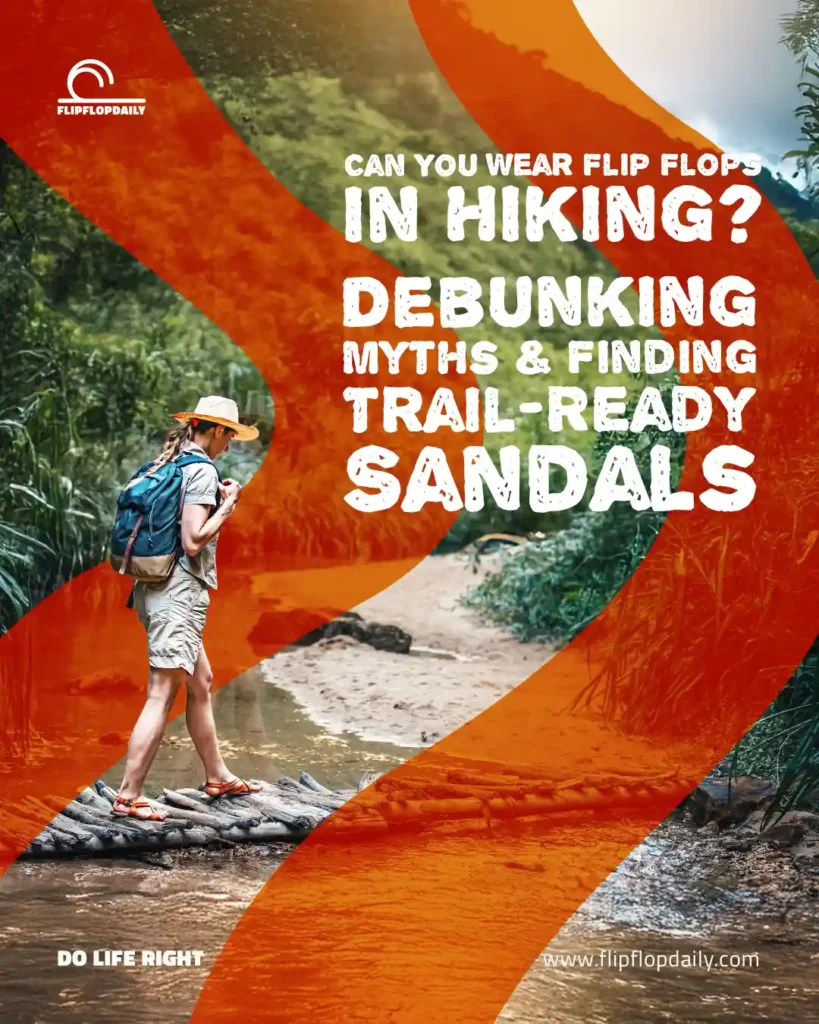Thinking of hiking in flip-flops? We break down why that’s risky, share what the experts say, and reveal the best trail-ready sandals from Teva, Chaco, and KEEN that give you breezy comfort without sacrificing safety.
The Daydream vs. The Dirt
It’s sunny, the trail looks inviting, and you’re thinking: “Do I really have to trap my feet in hot, sweaty hiking boots?” The fantasy? Ditch the clunky footwear, slide into flip-flops, and feel that sweet breeze between your toes.
Sounds nice… but before you head off into the wild in your beach thongs, let’s pump the brakes.
Hiking in regular flip-flops isn’t just a bad idea—it’s basically an invitation for blisters, twisted ankles, and other un-fun injuries. But here’s the plot twist: while cheap, flimsy flip-flops have no business on a trail, there are open-toed shoes built for hiking. Think of them as the cooler, trail-hardened cousins of your poolside pair.
Before we get into those, quick clarification—when hikers talk about a “flip-flop hike,” they usually mean a trail strategy, not footwear. On long trails like the Appalachian Trail, it’s when you start in the middle, hike one way, then go back and hike the other. Totally unrelated to sandals—but good to know so we’re not talking past each other.
Why Regular Flip-Flops Fail the Trail Test
The experts are unanimous: flimsy flip-flops are a foot disaster waiting to happen.
From a foot health perspective:
- They offer zero arch support and no cushioning, which means every step puts extra strain on your feet, ankles, and even your back.
- You end up curling your toes just to keep them on, messing with your natural gait. Over time, this can lead to nasty issues like plantar fasciitis, Achilles tendinitis, hammertoes, and shin splints.
From a hiker’s perspective:
- No protection from rocks, roots, thorns, or that rogue piece of glass hiding in the dirt.
- Slippery outsoles with zero grip. On wet rocks or loose gravel, it’s a one-way ticket to Slipsville.
- One wrong move and the thong pops out, or your sandal folds under your foot. Not great when you’re miles from the trailhead.
And the worst part? These risks compound. Your altered gait from toe-curling throws off your balance, making slips and ankle rolls more likely—and once you’re injured, you’re in real trouble.
Common Hiking Footwear Myths—Busted
Myth 1: You have to wear heavy boots.
Not true! Boots are great for rugged, technical terrain, but for well-maintained trails, there are lighter options like trail runners or—yep—purpose-built hiking sandals.
Myth 2: Flip-flops are always bad for your feet.
Mostly true for cheap ones, but there are supportive flip-flops with arch support and cushioning. Still, they lack the all-important heel strap, so they’re not safe for real hikes.
Myth 3: All sandals are the same.
Nope. There’s a huge difference between a $5 beach flip-flop and a $100 pair of engineered hiking sandals. The latter are designed like performance gear, with real support, traction, and durability.
What Makes a Sandal Trail-Ready?
Think of hiking sandals as a hybrid: the breeziness of open footwear + the structure of a good hiking shoe. Here’s what to look for:
- Support & Stability – Contoured footbeds, solid arch support, and a deep heel cup to keep your foot in place.
- Traction & Grip – Lugged soles (3mm or more) and grippy rubber compounds (like Vibram® or ChacoGrip™).
- Secure Fit – Adjustable straps + a heel strap so your sandal moves with you, not off you.
- Protection & Durability – Tough materials and, if you want, a closed-toe bumper for extra safety.
Our Picks for the Best Hiking Sandals
| Model | Best For | Toe Style | Key Features | Weight (Pair) |
| Teva Hurricane XLT2 | All-around value, water hikes | Open | Cushioned, grippy, adjustable, affordable | ~1 lb 4 oz |
| KEEN Newport H2 | Maximum protection, rocky trails | Closed | Protective toe bumper, stable, secure fit | ~1 lb 6 oz |
| Chaco Z/Cloud | Arch support & durability | Open | Podiatrist-certified footbed, comfy straps | ~1 lb 3 oz |
| Bedrock Cairn Evo | Minimalist feel, serious grip | Open | Vibram® Megagrip outsole, resoleable | ~15.6 oz |
| Hoka Hopara 2 | Cushioning & hybrid use | Closed | Plush midsole, protective toe, water drainage | ~1 lb 5 oz |
The Bottom Line
Hiking in basic flip-flops? Big nope. Hiking in actual trail sandals? Absolutely—if they’re built for it.
So if you want that open-air freedom without sacrificing safety, skip the $3 drugstore pair and invest in sandals that are as ready for adventure as you are. Your feet (and future self) will thank you.
It’s time to Do Life Right!
Check out the best flip flop reviews, flip flop advice and flip flop philosophy on how to live a flip flop life!

